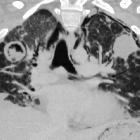umgekehrtes Halozeichen Lunge

Atoll-Zeichen am ehesten im Rahmen einer gleichzeitig nachgewiesenen Lungenembolie. Diese möglicherweise mehrzeitig, also dieser Befund als älterer Restzustand einer kleinen Infarktpneumonie zu werten.
Atoll-Zeichen
am ehesten im Rahmen einer gleichzeitig nachgewiesenen Lungenembolie. Diese möglicherweise mehrzeitig, also dieser Befund als älterer Restzustand einer kleinen Infarktpneumonie zu werten.

Atoll-Zeichen am ehesten im Rahmen einer gleichzeitig nachgewiesenen Lungenembolie. Diese möglicherweise mehrzeitig, also dieser Befund als älterer Restzustand einer kleinen Infarktpneumonie zu werten.
Atoll-Zeichen
am ehesten im Rahmen einer gleichzeitig nachgewiesenen Lungenembolie. Diese möglicherweise mehrzeitig, also dieser Befund als älterer Restzustand einer kleinen Infarktpneumonie zu werten.

CT scan of the chest of a 59-year-old with four months of progressive weight loss, fever, dry cough and dyspnea. it shows a reversed halo sign. A diagnosis of bronchiolitis obliterans organizing pneumonia was made.
CT scan of
the chest of a 59-year-old with four months of progressive weight loss, fever, dry cough and dyspnea. it shows a reversed halo sign. A diagnosis of bronchiolitis obliterans organizing pneumonia was made.

Thorax CT of a 74-year-old man with a long-standing pulmonary embolism (having lasted 3 months) of the artery of the right lower lobe, secondary to a leg fracture, and with long-standing hemoptysis. It shows the embolism, as well as a pulmonary infarction (white arrow) seen as a reverse halo sign (black arrow). Further information: Reverse halo sign
Thorax CT of
a 74-year-old man with a long-standing pulmonary embolism (having lasted 3 months) of the artery of the right lower lobe, secondary to a leg fracture, and with long-standing hemoptysis. It shows the embolism, as well as a pulmonary infarction (white arrow) seen as a reverse halo sign (black arrow). Further information: Reverse halo sign

Thorax CT of a 74-year-old man with a long-standing pulmonary embolism (having lasted 3 months) of the artery of the right lower lobe, secondary to a leg fracture, and with long-standing hemoptysis. It shows the embolism, as well as a pulmonary infarction seen as a reverse halo sign. Further information: Reverse halo sign
Thorax CT of
a 74-year-old man with a long-standing pulmonary embolism (having lasted 3 months) of the artery of the right lower lobe, secondary to a leg fracture, and with long-standing hemoptysis. It shows the embolism, as well as a pulmonary infarction seen as a reverse halo sign. Further information: Reverse halo sign

The Reversed Halo Sign in Pulmonary Mucormycosis with cerebral dissemination in immunocompromised host.. Axial (a), sagittal (b) and coronal (c) chest CT demonstrate a pulmonary mass with three components: central ground glass opacity (“reversed halo sign”) (*) and peripheral (arrow) ground glass opacity (halo sign) and intermedial consolidation.
The Reversed
Halo Sign in Pulmonary Mucormycosis with cerebral dissemination in immunocompromised host.. Axial (a), sagittal (b) and coronal (c) chest CT demonstrate a pulmonary mass with three components: central ground glass opacity (“reversed halo sign”) (*) and peripheral (arrow) ground glass opacity (halo sign) and intermedial consolidation.

Atoll-Zeichen ("reversed halo sign") rechts dorsobasal bei Lungeninfarkt bei zentraler Lungenembolie.
Atoll-Zeichen
("reversed halo sign") rechts dorsobasal bei Lungeninfarkt bei zentraler Lungenembolie.
Hallo!
 ähnliche Suchen
ähnliche Suchen siehe auch
siehe auchumgekehrtes Halozeichen Lunge
Siehe auch:


 Assoziationen und Differentialdiagnosen zu umgekehrtes Halozeichen Lunge:
Assoziationen und Differentialdiagnosen zu umgekehrtes Halozeichen Lunge: Kryptogene organisierende Pneumonie (COP)
Kryptogene
organisierende Pneumonie (COP)
Granulomatose mit Polyangiitis
Granulomatose
mit Polyangiitis







